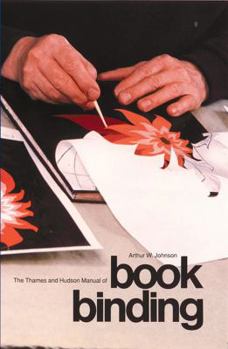The Thames and Hudson Manual of Bookbinding (Thames and Hudson Manuals (Paperback))
Select Format
Select Condition 
Book Overview
To give a book a worthy binding is one of the most satisfying of crafts. Beyond the utility of a good binding, there is a great deal of aesthetic pleasure to be gained from a book that opens easily and flatly, and from the decoration, the harmony of colors, and the brilliance of gold. Arthur Johnson, one of Britain's foremost designer-bookbinders, has written a manual of the craft whose clarity and comprehensiveness make it invaluable to the student and the professional. It covers equipment, tools, and materials; all stages of preparation (end papers, sewing, rounding and backing, edge-gilding, etc.); different binding styles; and the finer points of finishing. The illustrations show not only tools, materials, and processes, but also a selection of striking and beautiful examples of the binder's art, both historic and modern.
Format:Paperback
Language:English
ISBN:0500680116
ISBN13:9780500680117
Release Date:September 1981
Publisher:Thames & Hudson
Length:226 Pages
Weight:1.22 lbs.
Dimensions:0.7" x 6.7" x 9.6"
Customer Reviews
4 ratings
Badly printed and bound “Print on Demand” edition
Published by Nettle , 23 days ago
For a book about bookbinding, you think it’d be bound halfway decently. You’d be wrong.
The pages are unevenly and haphazardly glued in, the gutter margins are so small that you have to pry open the pages at the fragile spine in order to read it, plus the edition text is badly digitally pasted onto the copyright page and back cover in a mismatched font, ruining the meticulous design of the original.
I obviously wasn’t expecting an incredibly bound book at this price, but I at least expected it to be functional.
I think the author would be embarrassed to have this printing out there, I know I would.
More bookbinding!
Published by Thriftbooks.com User , 15 years ago
I bought this among others for my daughter. She decided that she wanted to get into bookbinding. During the summer, she worked at one of the big libraries in Philadelphis, PA doing for some hands-on learning. Now she is at the MIT library in Cambridge, MA doing the same thing. Nothing like the good old books.
A "Must Have" Book for the Serious Bookbinder
Published by Thriftbooks.com User , 23 years ago
Of the many popular books in print today on bookbinding, this one is by far the most comprehensive. It reads like a graduate level textbook and must be studied carefully; it isn't conducive to casual reading. Many of the sentences are difficult to understand and must be thought about for awhile to figure out. Nevertheless, I wouldn't want to undertake a new step in the binding process without first reading what this book has to say. I strongly recommend it for the serious student of bookbinding.
A very good instruction manual
Published by Thriftbooks.com User , 23 years ago
This book describes in clear detail how to properly bind a book for maximum durability. It includes details on case bindings (the easiest and weakest), library bindings (one of the strongest), flexible and sunk-cord bindings (traditional), and limp bindings. Although the author makes much about having the right tools, his descriptions are clear enough that one can improvise. With this book, I was able to make a book from paper, boards, and leather that came out quite well on my first try.






